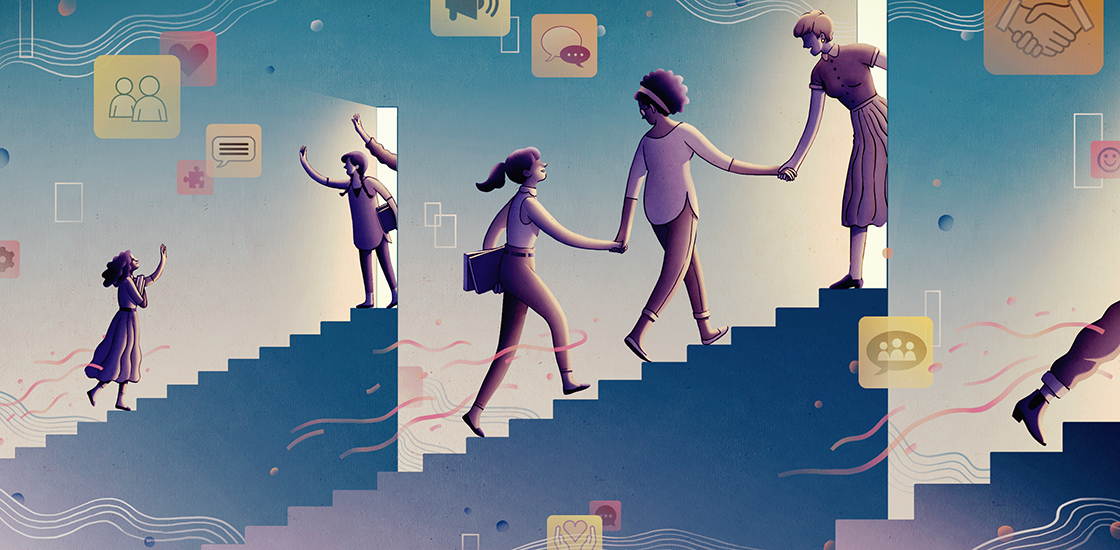THIS ARTICLE IS MORE THAN FIVE YEARS OLD
This article is more than five years old. Autism research — and science in general — is constantly evolving, so older articles may contain information or theories that have been reevaluated since their original publication date.

Nicole Brettell, 21, is studying art and creative writing at her local community college. Brettell has autism. Although she is an extremely bright young woman and a talented artist, she has difficulties communicating with others and some rigid thinking patterns that can interfere with forming relationships and accomplishing her goals — one of which is to attend a four-year university.
Brettell is part of a network of young women around whom she feels comfortable and confident. The network grew out of her participation in Girls Night Out, a social skills and self-care program at the University of Kansas Medical Center in Kansas City designed specifically to help girls with autism. The program has been a gateway for Brettell, since the age of 14, to build her own friendships and practice social interactions through skills groups and informal gatherings.
Beyond friendships, navigating the workplace and other community roles requires increasingly sophisticated social competence, especially for girls and women, who are expected to be more socially agile than boys and men. Yet few programs are designed specifically to develop social skills in girls with autism because much of what we know about the condition is based on boys. We need innovative approaches that promote social competence in girls on the spectrum and help them establish rewarding relationships.
Social isolation:
The lower prevalence of autism in girls has other implications as well. Boys tend to dominate autism programs and special education services, often limiting opportunities for girls with autism to socialize with other girls their age. At least one girl in our program expressed frustration at being the only girl at her school for people with autism. She felt socially excluded, despite sharing many of the boys’ interests, such as video games and Pokémon.
The problem compounds as these girls grow up. Compared with boys, adolescent girls face more complex social expectations and have a greater risk of anxiety or depression1. Thus, adolescent girls with autism may experience a ‘double whammy:’ increasing social difficulties during adolescence and more severe symptoms of anxiety and depression than occur in typical girls, or in boys with or without autism2,3,4.
In a not-yet-published study, my team compared the social experiences of girls with and without autism. We conducted separate focus groups with four types of respondents, including girls with and without autism and their parents. We talked to 14 girls with autism, 20 girls without autism and 27 parents altogether5.
The results so far suggest that adolescent girls without autism shift toward greater independence and less parent involvement within social activities and friendships. They describe coordinating social activities with peers. By contrast, girls with autism often continue to rely on parents to coordinate and facilitate social activities. Girls with autism and their parents report fewer social opportunities and more limited social networks.
Girls without autism describe friendships made through connections in classes, extracurricular activities and through “friends of friends,” emphasizing the importance of frequent interactions with a peer group. They also report that at social gatherings, they often make plans for the next get-together. When asked about making friends, girls with autism talk mostly about people in school or organized groups such as the Girl Scouts, rather than self-initiated social activities.
Opportunities for peer interactions become more important as girls shift from playdates and parent-coordinated activities toward peer-initiated social opportunities and an emphasis on establishing relationships. With a diminished pool of potential friends, girls with autism may miss out on the benefits of forming relationships, possibly increasing their risk of depression and anxiety.
Many social skills interventions for individuals with autism are short, lasting about three or four months. These can improve targeted social skills, but they have less impact on the ability to use skills over time and across various social situations and people. Interventions for girls with autism should take into account how social expectations change with age, and the potential consequences on girls’ social and emotional health.
Girls night out:
I launched Girls Night Out in 2008 with the goal of establishing interventions designed specifically for adolescent girls with autism and to create social opportunities and skill practice across a variety of settings. The intervention is designed to enhance social-communication skills and promote positive social-emotional health. The curriculum focuses on three areas: relationship building, self-care skills related to hygiene and self-presentation, and individual autonomy. By increasing competence and confidence in these areas, Girls Night Out aims to mitigate symptoms of social anxiety or depression.
In the program, groups of 8 to 10 teenage girls (ages 14 to 19) meet weekly for 12 to 14 weeks. The meetings do not occur in a clinic. Instead, we create opportunities to practice skills in a variety of social settings, such as a restaurant, coffee shop, hair salon or fitness center.
The program includes girls without autism as well. Peer volunteers attend brief trainings prior to most sessions, outlining their role not as a helper, but as an active participant in the program. They help create situations to elicit skill practice, such as learning to pause for longer periods of time so another girl can respond.
Facilitators provide feedback when girls use the desired skills, tailored to help reinforce individual goals. Providing training to peers and community members within these natural settings helps make communities more inclusive. Brettell and her family say the program strengthened her communication skills and provided a much-needed social network with other girls her age.
After a few years of Girls Night Out, we expanded our scope. In an effort to provide more social opportunities, we host larger events, such as our holiday party. These are less structured and are open to past participants or girls waiting to complete the skills group. Parents, including Brettell’s mother, initiated a Parent’s Night Out component to network and share resources, and they often coordinate alumni events to reconnect with one another. We are beginning a program next month for younger girls, aged 10 to 13.
Many participants with autism report improvements in their perceived social competence, self-worth and quality of life after completing a session of Girls Night Out6. But we would be remiss to say that Girls Night Out, or any other short-term social skills program, can adequately prepare girls on the spectrum to deftly navigate all of the complex social situations they will encounter. The long-term impact of our program also remains unclear.
In particular, the impact is likely to wane without continued support. In making plans to attend a university, Brettell is not worried about classes; instead, she is anxious about getting along with a roommate, handling romantic relationships and other social demands.
A diagnosis of autism implies social-communication difficulties that often persist across development and contexts. We need innovative and strategic approaches that consider a developmental framework, contextual changes and individual variability.
We envision a future that includes programs that allow girls and women with autism to achieve their goals over the long term. This means providing supports earlier, and for longer than just a few months. These programs should help girls make connections within natural social networks that can serve them over their lifetime. Programs beginning to address these issues include an initiative at the Yale Child Study Center and the New York City-based Felicity House.
Young women with autism often have ambitious goals and numerous talents. We cannot ignore the gaps in their social experiences. These girls need ongoing, innovative programs that enhance their strengths, help them anticipate challenges and widen their social circles.
Rene Jamison is associate professor at the University of Kansas Medical Center.

By joining the discussion, you agree to our privacy policy.